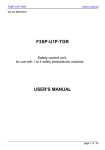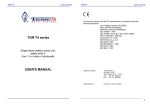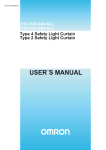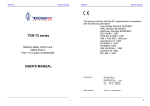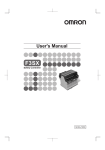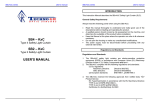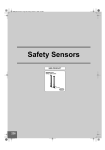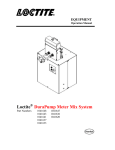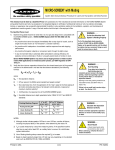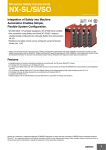Download F3SP-U3P-TGR Users Manual
Transcript
Cat. No. E04E-EN-01 Cat. No. E04E-EN-01 F3SP-U3P-TGR Single Beam Safety Control Unit/Safety Level 2 USER´S MANUAL Authorised Distributor: Cat. No. E04E-EN-01 Note: Specifications subject to change without notice. Printed in Europe F3SP-U3P-TGR Series Single Beam Safety Control Unit Safety Level 2 USER´S MANUAL F3SP-U3P-TGR User's manual Cat. No. E04E-EN-01 F3SP-U3P-TGR series Single beam safety control unit, safety level 2, from 1 to 2 pairs of photocells E3FS USER'S MANUAL 1 F3SP-U3P-TGR User's manual The device conforms with the EC requirements in compliance with the following standards: -Low Voltage Directive 73/23/EEC -EMC Directive 89/336/EEC -Machinery Directive 89/392/EEC -IEC 61496-1: 1997 -IEC 61496-2 ed.2 IEC 2001 (CDV draft 8) -DIN V VDE 0801: 1990 and -amendment A1: 1994 -EN 61000-4-2,-3,-4,-5,-6 -EN 55022: 1994 -DIN EN 60204-1: 1993 -EN 50178: 1998 -IEC 664-1: 1997 MANUFACTURER: TECHNO-GR s.r.l. via Torino, 13/15 10046 Poirino (TO) - ITALY Tel. +39 011 9452041 FAX +39 011 9452090 USER MANUAL: Version 3.0 of 12/06/2003 3 F3SP-U3P-TGR User's manual INDEX 1 BEFORE USING THE DEVICE. ......................................................5 1-1 1-2 1-3 GENERAL INSTRUCTIONS. ............................................................................5 PRECAUTION OF SAFETY .............................................................................5 ROUTINE MAINTENANCE...............................................................................5 2 GENERAL INFORMATION AND MAIN APPLICATIONS..............6 3 OPERATION....................................................................................8 4 PRECAUTIONS AND INSTALLATION CRITERIA. .......................9 4-1 4-2 5 CALCULATION OF THE MINIMUM INSTALLATION DISTANCE.....................9 REFLECTIVE SURFACES. ............................................................................10 CONNECTIONS............................................................................ 11 5-1 5-2 5-3 REFERENCES ON THE TERMINAL BOARD.................................................11 PIN OVERVIEW..............................................................................................12 WIRING EXAMPLE.........................................................................................13 6 ALIGNMENT PROCEDURE......................................................... 15 7 OPERATING PROCEDURES. ..................................................... 16 7-1 7-2 7-3 7-4 7-5 7-6 DIP-SWITCHES CONFIGURATION...............................................................16 CONFIGURATION OF THE NUMBER OF PHOTOCELLS.............................16 MUTING FUNCTION. .....................................................................................17 7.3.1 DESCRIPTION......................................................................................17 7.3.2 INSTALLATION CRITERIA ..................................................................18 OVERRIDE. ....................................................................................................20 STARTING THE OVERRIDE FUNCTION.......................................................20 MUTING RESTRICTIONS (MUTING FUNCTION)................................................21 8 LED DIAGNOSTIC. ...................................................................... 22 9 FINAL CHECKS. .......................................................................... 23 10 ROUTINE MAINTENANCE OPERATIONS. ................................ 23 11 GENERAL INFORMATION AND USEFUL DATA. ..................... 24 12 TECHNICAL DATA. ..................................................................... 25 13 OVERALL DIMENSIONS. ............................................................ 26 4 F3SP-U3P-TGR 1 User's manual BEFORE USING THE DEVICE. 1-1 GENERAL INSTRUCTIONS. Read this manual and the manual of safety PES (safety photoelectric switch) carefully and completely. Make sure the user information provided is understood before attempting to operate the safety PES. Keep the manual in a secure and convenient location and confirm information if necessary. To guarantee correct installation, carefully follow the instructions of this manual. • Do not touch non-insulated cables, unless they have been disconnected from the power supply. • Make sure that the cables connected to the control unit are not taut and that they do not hinder the movement of persons or objects. • Before carrying out any outer operation, turn off the power. Failure to do so may result in lethal or serious injury. 1-2 PRECAUTION OF SAFETY The following symbols are used for highlighted items in order to ensure safe and proper use of the F3SP-U3P-TGR. Highlighted items are critical for safe operation and must be heeded at all time. NOTICE WARNING 1-3 ROUTINE MAINTENANCE. Be sure to conduct inspection regularly. Please refer to sec.10 and the safety PES instruction manual. Omron Europe and Techno-GR refuses to accept any responsibility for damage to persons or object due to the incorrect use / installation of the control unit and safety PES. 5 F3SP-U3P-TGR 2 User's manual GENERAL INFORMATION AND MAIN APPLICATIONS. The single beam safety control unit F3SP-U3P-TGR has been designed and produced to meet the need to protect persons in areas where it is necessary to guarantee the safety of the operator using machinery, robots or in general automation systems which are considered dangerous or subject to casual or undesired access to unsafe parts. The system conforms with the requirements for safety devices of type 2 in compliance with international standards, e.g. IEC 61496 1-2. This safety device is made up of a control unit protected by a plastic container so that it can be installed on a DIN/OMEGA guide; it has 16 removable screw terminals to which it is possible to connect from 1 to 2 pairs of photocells. This version of the single beam safety control unit has the ‘muting’ function integrated, by means of this function it is possible to connect or disconnect one or more pairs of photocells in order to allow - for instance - the material passage without stopping the machine. The additional ‘override’ function enables system, to keep the output relays closed even with intruded rays to enable material transport after a system shutdown. Both muting and override functions represent a system that require additional precautions to limit the reduction of the safety level. This precautions have to be considered carefully. The muting and override function is available by simply connecting the F39A11 muting lamp (or similar yellow bulb type lamp for 24VDC / 3W to 7 W) supplied separately. The presence of a limb or an object interrupting a beam causes the opening of the safety outputs and the consequent stopping of the connected machine. It is necessary for the safety sensors to be connected in the right position in such a way that there isn’t any possibility to climb over or defeat the system. Here is a list of the commonly used applications: ◊ Machines for the processing of wood, glass and ceramic products. ◊ Automatic warehouses. ◊ Conveying lines. ◊ Palletizers 6 F3SP-U3P-TGR User's manual The unit has been designed in accordance to the following standards: IEC 61496-1: 1997. FDIS IEC 61496-2: 1997. Safety of machinery: electro-sensitive protective devices - General requirements and test. Safety of machinery: electro-sensitive protective devices - Particular requirements for system using active opto-electronic devices. 7 F3SP-U3P-TGR 3 User's manual OPERATION. The electronic control system of the device is made up of a microprocessor. By means of the suitable hardware, it continuously control and check the connected photocells. No interference among the photocells is possible as they are controlled sequentially; it will be thus possible to install one or two adjacent photocells. When one or more beams are interrupted, the electronic system opens the outputs . The photocells have been triggered are displayed by LEDs on the housing. The control-unit can work in two different modes (please refer to par. 7 page 14) which he can carry out the following operations: The two external buttons that have to be connected are for: • TEST : This is used to check if the whole system works effectively. By pressing the TEST button (opening of the contact), this simulates the interruption of one or more safety PESs. This operation makes the machine stop, so the system checks can be made according to the established time and modes. If pressed after a failure detection of the unit (see the table error code), reset of the system is required. • RESET button: It is used to start the system, also for manual reset condition after relay triggering or after an error which can be reset (see table related to the error codes). Two different operating modes are available: 1. Automatic reset: The system will start automatically after the beam intrusion have been removed. 2. Manual reset: The system will remain in safe off condition until the RESET button have been pressed. This manual reset allows to start the system only on a wanted action of the user. During the unit working, no operation set by the user interface involves functions which can influence the system safety. 8 F3SP-U3P-TGR 4 User's manual PRECAUTIONS AND INSTALLATION CRITERIA. The safety products used must be suitable for the required application, and other influences must be also taken into account such as a room temperature, electromagnetic interference, intense light sources etc. Please refer to the manual for specification or contact the manufacturer for details 4-1 CALCULATION OF THE MINIMUM INSTALLATION DISTANCE. The safety distance ‘S’ must be sufficient to guarantee that the dangerous area cannot be reached by the operator up to the moment in which the machine with moving part stops. The safety distance must be calculated according EN999 (European Standards. Safety of Machinery – The positioning of protective equipment in respect of approach speeds of part of the human body) Using EN 999 formula: S=(K*T)+C S T K C = safety distance. = T1 + T2 whereas T1 = machine response time in seconds. T2 = unit response time in seconds including Safety sensor response time. = 1600 mm/s (speed of the body approaching the dangerous area). = additional distance depend on resolution of SLC and applicable standard 1) Multiple separate beams (EN999, clause 6.1.4) K = 1600 mm/s C = 850 mm Heights recommended in EN999 st Heights of 1 ray nd Heights of 2 ray 4 Beams 3 Beams 2 Beams 300 mm 300 mm 400 mm 600 mm 700 mm 900 mm 2) Single height beam (EN999, clause 6.1.5) WHERE THE RISK ASSESSMENT ALLOWS THE USE OF A SINGLE BEAM, THE FOLLOWING VALUES CAN BE USED K = 1600 mm/s C = 1200 mm The height of beam from the ground or reference plan: 750mm (EN 999) 9 F3SP-U3P-TGR User's manual WARNING. Always maintain the safety distance between the safety PES and a hazardous part of a machine. 4-2 REFLECTIVE SURFACES. In case that reflective surface exist, the distance must be sufficient to avoid the possibility of passive reflections. <Top View> reflective material A RX bar TX bar 2° 2° 2° Object 2° A reflective material Distance between emitter and receiver (detection distance L) 0.3 to 3m Minimum installation distance D 0.27 m 3m or more L x tan 2° = L x 0.034 (m) WARNING. Do not install the safety PES in a location affected by shiny surface reflections. 10 F3SP-U3P-TGR 5 User's manual CONNECTIONS. 5-1 REFERENCES ON THE TERMINAL BOARD. TERMINAL BLOCK ASSIGNMENT TERMIN AL 1-2 OUTER CONNECTION Connect to the 24 Vdc power supply, 1 to 24Vcc and 2 to 0Vcc 3 Connect the muting signaller LMS. 4 Connect to the ground of plant. 5 TEST button; connect a normally closed button (N.C.). 6 RESET button; connect a normally open button (N.O.). 7 Input of the muting A sensor. Connect to the N.O. contact of the muting sensor (photocell, proximity switch, other). 8 Input of the muting B sensor. Connect to the N.O. contact of the muting sensor (photocell, proximity switch, other). 9 Connect the photocells test input of transmitters TX1. Black wire (pin 4 of connector). 10 Connect to the PNP output of the receivers RX1. Black wire (pin 4 of connector). 11 Connect the photocells test input of transmitters TX2. Black wire (pin 4 of connector). 12 Connect to the PNP output of the receivers RX2. Black wire (pin 4 of connector). 13 - 14 (OUT1) safety output 1 with N.O. contact. 15 - 16 (OUT2) safety output 2 with N.O. contact. 11 F3SP-U3P-TGR 5-2 User's manual PIN OVERVIEW 12 F3SP-U3P-TGR 5-3 User's manual WIRING EXAMPLE. Connection of 2 safety PES to the control unit. GND Muting A-B MAIN SUPPLY 24 V DC T E S T TOP VIEW R E S E T N. C. EXTERNAL FUSE N. A. F39A11 1 2 3 4 5 6 7 8 F3SP-U3P-TGR control unit 9 T E S T E3FS Transmitter 10 11 12 13 14 15 16 P N P O U T T E S T Safety output 2 P N P O U T E3FS Receiver Safety output 1 E3FS Transmitter E3FS Receiver 13 F3SP-U3P-TGR User's manual Please, note: • • • • • • • • • • All models can be connected in all the possible combinations for a maximum of two pairs of sensors with at least one pair connected. In the following paragraph you can find the codes of the available models which can be used in the configuration. The power supply which is necessary to power the system must conform to standard EN 60742 (double insulation) or with equal insulation, for instance VDE 0551. It is necessary to protect the control unit with an outer fuse having a nominal interruption current equal to 1 A. The TEST and RESET pushbuttons must be positioned in such a way that the operator can see the protected area when he restarts, or carries out a test or override operation. The Muting lamp (F39-A11) must be positioned in a place where it can be seen from any operative point. Read the paragraph relating to the muting function and its use for the positioning of the activation sensors of this function. Both safety contacts OUT1 and OUT2 must be connected. If the machine has a single locking circuit, the two normally opened contacts must be connected in series. Photocells of the type E3FS, S5-5 and S10-5 are delivered with wired cable or standard M12 connector and the wiring on the control unit is indicated according to the cable colour, or to the male connector pin number. Photocells of the type S30-5 are available also in the version with terminal board. The connection cables of the photocells, of muting request, start and test must be masked with minimum section 22AWG. The screen braids must be all earthed towards the control unit side. 14 F3SP-U3P-TGR 6 User's manual ALIGNMENT PROCEDURE. After having carried out the correct mechanical assembly and the correct connections as described in the previous paragraphs, it is necessary to align the pairs of photocells. Follow the operative modes as follows: • • • • • • • • Turn off the power supplying the control unit. Open the TEST pushbutton. Power the control unit. Align the photocells by observing the LEDs on the control unit: If the alignment of the relevant pair of photocell is correct, the corresponding LED will turn on. After the alignment, turn off the power supplying the control unit, close the TEST pushbutton and re-power the control unit again. Wait for the control unit to carry out the initial tests. At the end of this operation, the unit indicates the right alignment with the guard led green on. Carry out all the checks described in the final checks and in the routine maintenance operations. During aligning operations or normal working, check that the photocells connected to the same or other units do not interfere which each other, modifying their mutual position, for instance by positioning some pairs of transmitters on the other receiver side. NOTICE The control unit can detect the mutual interference between safety PESs. The control unit forces the output contact to open, when it detects external disturbance light including mutual interference light. The safety PESs should be installed the following way to avoid mutual interference. - The safety PESs are installed with sufficient distance. - Emitters and receivers of safety PES are installed alternately as follows: TX RX RX TX 15 F3SP-U3P-TGR 7 User's manual OPERATING PROCEDURES. 7-1 DIP-SWITCHES CONFIGURATION. The configuration indicated in the table must be selected on the dip-switch available in the front. X SW 1 Function 4 4 not used 3 Function 3 Off On muting A-B act on the sensor couples 1 and 2. muting A-B act on the sensor couple 1. ON 1 Function 2 Off muting 60 s On muting ∞ s * 1 2 Function Off manual restoring On automatic restoring The control-unit is manufactured from the factory with the following configuration: • Automatic reset, all 2 sensors in muting, the maximum duration of the muting is of sixty seconds. * infinite muting duration: this feature must be used carefully because it’s against the norm. Using this, the user must know that it works under its sole responsibility. 7-2 CONFIGURATION OF THE NUMBER OF PHOTOCELLS. In case you use only a pair of photocells, operate as follows: Turn off the power and short the terminal 11-12. At least one pair of photocells must be connected, otherwise the control unit is locked. 16 F3SP-U3P-TGR 7-3 User's manual MUTING FUNCTION. 7.3.1 DESCRIPTION. As mentioned in the introduction, the muting function can be enabled with any unit by simply connecting the F39-A11 muting lamp when the unit is switched off. This presence of this indicator is recognised every time the unit is powered on. If its presence is detected, the unit will enable the muting function and if its presence is not detected the unit will ignore any request for muting. It is important to note that if the muting indicator is connected during the F3SP-U3P-TGR is powered on, it will not be recognised and the muting function will not be enabled. Once enabled, if the indicator develops a fault or is removed without first disconnecting the unit’s power supply, it will signal an error as described in section 8. To disable the muting function, the unit’s power supply must be turned on without the F39-A11 muting lamp connected. In brief: this function, present on all units, is enabled and disabled by means of the following simple procedure: - Disconnect the unit’s power supply. - Connect the appropriate F39-A11 muting lamp and the muting sensors. - Restore the unit’s power supply. Bypass the muting function as follows. - Disconnect the unit’s power supply. - Disconnect the F39-A11 muting lamp and the muting sensors. - Restore the unit’s power supply. 17 F3SP-U3P-TGR 7.3.2 User's manual INSTALLATION CRITERIA 1. The muting sensors must recognise the material (pallets, vehicles, etc.) in all its length. 2. The sensors must be arranged in such a way that the material is recognised even when it must be lifted for the relevant processing. 3. In case of different transport speeds in the muting area, always bear in mind their influence on the muting total duration. 4. All the safety photocells and the muting sensors must be arranged in such a way that the previous material has already passed the last muting sensor before the new material has reached the first sensors. S2 S1 GOODS 1 B2 A2 GOODS 2 B1 A1 In the previous figures, an installation example of a protection arranged on a conveyor is drawn. The protection photocells S are connected to the F3SP-U3P-TGR control unit and are temporarily interrupted at the package passage by means of the muting A1, A2, B1 and B2 activated sensors. Sensors A and B are optical, mechanical, proximity, etc. sensors with closed contact in the presence of the object to be detected. 18 F3SP-U3P-TGR User's manual Typical application with four muting sensors: Muting sensor connection: 24 VDC contact of A1 L v B2 A2 B1 A1 S contact of A2 7 MUTE A contact of B1 8 MUTE B d1 F3SP-U3P-TGR terminals D contact of B2 Application with two muting sensors, passage permitted only for package 1: Muting sensor connection: 24 VDC contact of A B S 7 MUTE A 8 MUTE B A d1 = D contact of B F3SP-U3P-TGR terminals D: minimum distance so that the muting sensors keep active the request; it depends on the parcel length: D < L. d1: necessary maximum distance so that the muting request is accepted; it depends on the parcel speed: dmax [cm]= v[m/s] * 3[s] * 100 This distance must not allow to activate both sensors and the muting with the accidental passage of a person. To allow the muting function only for the first photocells it’s necessary to set the unit with the dip-switch number 3 in ON. To allow the muting function for both the photocells the dip-switch number 3 must be setted OFF. 19 F3SP-U3P-TGR • • • • • User's manual The TEST and START pushbuttons must be positioned in such a way that the operator can see the protected area when he carries out start, test or override operations. The F39-A11 muting lamp must be positioned in a place where it can be seen from any operative point. If the muting sensors are installed very near the protection photocells, it is necessary to install the sensor receivers on the photocell sender side to avoid interference. The system is anyway protected from possible failures due to the cable damage; it is necessary to prepare the wiring of all connections so as to avoid damage to the connection cables. The control unit must be located in a cabinet with protection degree of at least IP54. 7-4 OVERRIDE. This function makes it possible to force a muting condition, if it is necessary to start the machine despite one or more rays have been interrupted by the material. The aim is that of removing from the protected area the material which has possibly gathered before the photocells for instance because of a failure of the machine cycle. Let’s suppose that a pallet has stopped before one or more used optical devices; the conveyor belt cannot be started again because the control unit - after having detected one or more interrupted rays - will not close the safety outputs, thus making it impossible to free the controlled area. By starting the override function, it will be possible to carry out this operation. 7-5 STARTING THE OVERRIDE FUNCTION. • Switch off the device. • Make sure that the TEST e START buttons are connected. (N.C. for the TEST button, N.O. for the START button). • Switch on the device. • Within 10 seconds, press together the test and reset buttons and keep pressing. (At each switching on operation, a test is carried out to check that the buttons are not locked). • The override function has been activated. The muting lamp blinks to signal the barrier disconnection. • The maximum duration of the override function amounts to 60 seconds after that the unit is connected again even if the buttons are pressed. Obviously, if the buttons are released before this time has elapsed, the override function will be immediately stopped. 20 F3SP-U3P-TGR 7-6 User's manual MUTING RESTRICTIONS (muting function). a) The request of muting must occur according to the correct time sequence; it is necessary to activate input MUTE_A at first and then input MUTE_B. The request of this last one must arrive within a maximum time of 3 seconds. If not the muting request will not be activated. A wrong sequence on the entrances of muting does not activate this function. b) Since when the muting state is active, an object can remain for a period of time not longer than 60 s., otherwise the muting function is switched off. This mechanism is optional and can be deactivated when the barrier is set up with the dip-switch. c) For all the cases in which the muting function is automatically disabled because of time-out, the request must be cut-out and reactivated to generate the following muting state. MUTE_A 30 ms min MUTE_B 3 s max ON MUTE_STATE OFF OFF ∞ / 60 s max It is not possible to carry out a muting request, if the barrier is in the opened relay state. 21 F3SP-U3P-TGR 8 User's manual LED DIAGNOSTIC. Information of the units operative state by means of four LEDs. The LED state has the following meaning: • GREEN LEDS OUT: if switched on, the related photocells work regularly and no object is detected, the relays are closed. • GREEN LED STATUS: if switched on, all the unit test are correctly passed, if blinking an error occurred. • RED LED BREAK : if switched on, the unit has detected an object or an error has occurred - which can be possibly recovered by pressing the reset button -; in this condition, the safety outputs are opened. • GREEN LED GUARD: if switched on, in green, the barrier is working regularly and there are no detected obstacles; in this condition, the safety outputs are closed. The F3SP-U3P-TGR has inside an easy diagnosis with the four green leds to detect the most common errors or failure that can be presents: • One led flashing: Probable error in a photocells pair. • Two leds flashing: Probable incorrect setting of numbers of beams connected. • Tree leds flashing: Probable fail in muting lamp connection. • Four leds flashing: Probable internal error. All these errors are resettable by the TEST pushbutton if the error condition can be removed. THE TWO LED OUT 1 AND OUT 2 CAN INDICATE A STATUS ONLY IF THE OPTICAL BEAMS ASSOCIATED TO THE LED FLASHING ARE FREE. IF THE BEAMS ARE INTERRUPTED THE LEDS CAN ONLY BE OFF. 22 F3SP-U3P-TGR 9 User's manual FINAL CHECKS. Check that the area protected by the beams is free from any obstacle; check the correct triggering of the safety relay opening by interrupting the protection rays (red LED switched on, controlled machine stopped). CAUTION! If the red LED switches on and off, check the correct mechanical assembly. NOTE. This check must be repeated each time you move or mechanically re-align the photocells. 10 ROUTINE MAINTENANCE OPERATIONS. Here is a list of checks recommended to the user to be carried out periodically by skilled workers: • Check that the unit locks by inserting an object detecting the single elements of each photocell. • By opening the test contact, check that the safety relays are opened (red LED switched on and machine under test stopped). • Make sure that the access to the machine dangerous areas is not possible from any non-protected area and that the minimum distance from the beam dangerous parts is not lower than the one calculated with reference to the formula reported at paragraph 4.1. • Check that it is not possible for a person to stop between the beams and the dangerous parts of the machine. • Make sure that there is no outer damage to the unit and/or the outer electrical connections. • Make sure that the response time - including the unit and the machine ones - does not exceed the established limits. The frequency of these operations depends on the special applications and operative conditions according to which the unit is working. 23 F3SP-U3P-TGR User's manual 11 GENERAL INFORMATION AND USEFUL DATA. Safety MUST be part of our consciousness. The safety devices are useful only if installed correctly by respecting the indications reported on the standards. If you believe not to have the sufficient competence to correctly install the safety devices apply to our advisory service or request the installation. We recommend to leave free space on the cover side to allow a possible easy access to the inner parts. Trouble that cause voltage interruption on power supply may cause temporary openings of the outputs that are not damaging in any case the safety work of the unit. The guarantee is complete for a period of 12 months starting from the delivery date of the device. Defects which are clearly due to damage caused by an incorrect use, accidental causes or catastrophic events are not covered by the guarantee. 24 F3SP-U3P-TGR User's manual 12 TECHNICAL DATA. • Voltage: 24 Vdc ± 10% • Electrical input: 420 mA max. • Combinable photocells: OMRON E3FS series and Techno GR S5 – S10 – S30 series • Number of photocells: two pairs max • Wire range: size AWG 16 – 24 Solid/Stranded • Wire type: 60/75 °C copper (Cu) conductor only • Torque on terminals: 0.9 N*m • Indicators: 5 green LEDs, 1 red LED • Response time: ≤ 30 ms • Working temperature: -10 a + 55 °C • Moisture: from 15% to 95% (not condensing) • Output contacts: 2 NO, 115 Vac 2.5 A max • Switch capability: 1,500 VA, 180W • Electrical life expectance: 100.000 op. minimun at 1,800 oprs/hr. • Operative distance: according to the type of photocell E3FS 10m S5-5 8m S5-10 8m S30-5 50m • Outer controls: start control, test, muting and override • Housing: plastic case for installation on a din/omega guide • Protection class of control unit: IP 20 • Protection class of photocells: IP 67 • Protection class of the cabinet containing the control-unit: IP54 at least • Weight: control unit: 300 g • Features of fuses muting signalling lamp: internal re-settable fuse 315mA 60V • Muting signalling: F39-A11 25 F3SP-U3P-TGR User's manual 13 OVERALL DIMENSIONS. Control unit F3SP-U3P-TGR 26 MANUFACTURER TECHNO-GR s.r.l. Via Torino, 13/15 10046 Poirino (TO) ITALY Tel: +39-011-9452041 / FAX: +39-011-9452090 GENERAL AGENCY OMRON EUROPE B.V. SENSOR BUSINNES UNIT Carl-Benz-Str. 4 71154 Nufringen GERMANY Tel : -49-7032-811-0 / FAX : -49-7032-811-199 Authorized distributor :





























